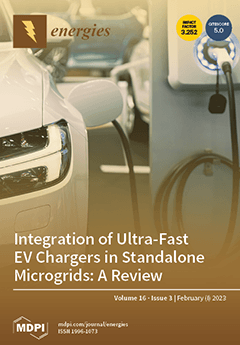The current study focuses on the synthesis of Cerium oxide (CeO
2) nanocatalyst via Tragacanth Gum (TG) using the wet impregnation method and its application for sustainable biodiesel production from a novel, non-edible
Descurainia sophia (L.) Webb ex Prantl seed oil. The
[...] Read more.
The current study focuses on the synthesis of Cerium oxide (CeO
2) nanocatalyst via Tragacanth Gum (TG) using the wet impregnation method and its application for sustainable biodiesel production from a novel, non-edible
Descurainia sophia (L.) Webb ex Prantl seed oil. The
D. sophia seed oil has higher oil content (36 wt%) and free fatty acid (FFA) value (0.6 mg KOH/g). Innovative analytical methods, such as X-ray diffraction (XRD), scanning electron microscopy (SEM), energy dispersive X-ray (EDX), transmission electron microscopy (TEM), thermogravimetric analysis (TGA), and Fourier transform infrared spectroscopy, were used to characterize the newly synthesized, environmentally friendly, and recyclable CeO
2-TG phytonanocatalyst (FT-IR). The results show that the CeO
2-TG phytonanocatalyst was 22 nm in diameter with a spherical shape outer morphology, while the inner structure was hexagonal. Due to low FFA content, the
D. sophia seed oil was pretreated and transesterified via a single step. Using varying parameters, the optimized process variables were determined via Response Surface Methodology (RSM). The optimum process values were 8:1 methanol to oil molar ratio, 0.3 wt% catalyst concentration, 90 °C temperature, and reaction time of 210 min with 98% biodiesel yield. The recently created phytonanocatalyst was reliable and effective, with three times reusability in the transesterification reaction. Thin layer chromatography (TLC), FT-IR, gas chromatography–mass spectroscopy (GCMS), and Nuclear magnetic resonance (NMR) analyses were used to characterize the synthesized biodiesel. Physico-chemical properties of
D. sophia biodiesel, i.e., Kinematic viscosity (4.23 mm
2/s), density (0.800 kg/m
3), pour point (−7 °C), cloud point (−12 °C), and flash point (73.5 °C) agree well with international biodiesel standards (ASTM-6751, 951), (EU-14214), and China (GB/T 20828) standards. The results show that the synthesized nanocatalyst demonstrated remarkable stability, indicating a bright future for industrial biodiesel production from low-cost feedstock.
Full article





